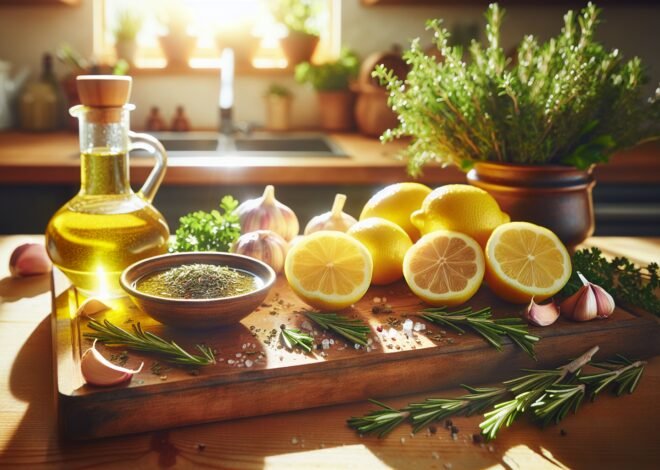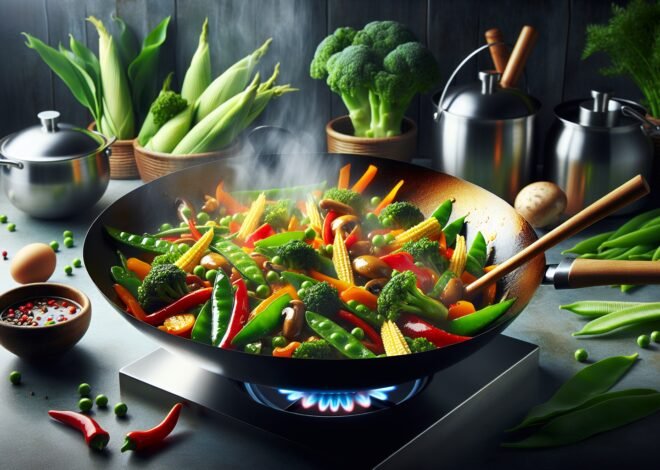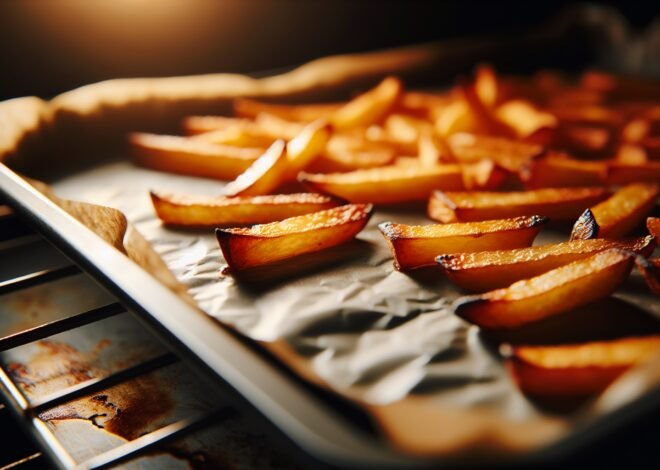
How to Stir-Fry Without Overcooking: Tips for Retaining Freshness
Avoid overcooking when stir-frying to maintain the vibrant taste and texture that make this cooking method so appealing. Did you know that the secret lies in balancing heat, timing, and ingredient preparation? This guide will explore essential tips like choosing the right oil, understanding cooking times for various ingredients, and leveraging the power of high temperatures to cook food quickly and evenly. By following these techniques, you’ll retain the freshness and nutritional value of your dishes, making each meal a flavorful delight. Stay tuned to master the art of stir-frying without sacrificing quality or taste.
Techniques for Perfect Stir-Frying Every Time
Stir-frying is an art that transforms simple ingredients into a delightful dish. Achieving perfection requires mastering a few essential techniques. By focusing on the right oil, timing, and heat, anyone can make a delicious stir-fry. Let’s explore how to elevate your stir-frying game with these effective methods.
Choosing the Right Oil for High-Temperature Cooking
The oil you choose lays the foundation for your stir-fry. It’s essential to pick an oil that withstands high heat without smoking. Oils like peanut, canola, and grapeseed are superb choices due to their high smoke points. This ensures that the food cooks evenly without any burnt undertones.
- Peanut Oil: Its light flavor and high smoke point make it a favorite among chefs.
- Canola Oil: Known for its neutral taste, it allows the ingredients’ flavors to shine.
- Grapeseed Oil: Ideal for health-conscious cooks, packed with nutrients and a clean taste.
Use the right amount of oil to coat your pan evenly. Too much oil can overwhelm, making the dish greasy. Strike a balance to keep the dish light and flavorsome.
Timing Each Ingredient for Optimal Results
Stir-frying is all about precision. Each ingredient has its own cooking time, and layering them correctly ensures each piece is cooked to perfection. Start with the ingredients that require the longest cooking time, such as meats and dense vegetables like carrots or broccoli. Follow with quicker-cooking items like bell peppers or snow peas. Lastly, add herbs and aromatics to infuse the dish with flavor.
- Start with Proteins: Cook chicken, beef, or tofu until browned.
- Add Dense Vegetables: Include carrots, broccoli, or cauliflower.
- Include Tender Vegetables: Stir in items like bell peppers or mushrooms.
- Finish with Aromatics: Add garlic, ginger, and herbs for a burst of flavor.
Maintain a steady pace to prevent overcooking. Keep stirring to distribute heat evenly and achieve the perfect texture.
Properly Pre-heating Your Pan for Even Cooking
The right heat is pivotal in achieving that signature stir-fry texture. Pre-heating your pan ensures even cooking and locks in flavors. A well-heated pan creates a sizzle that sears ingredients, adding depth and aroma to your dish.
- High Heat: Begin with high heat to bring the pan to the correct temperature quickly.
- Even Coating of Oil: Add oil only once the pan is hot to prevent sticking.
- Test with Water: A few drops should sizzle instantly when the pan is ready.
Pre-heating also prevents ingredients from steaming in their own juices, maintaining that desirable crunch and vibrant color.
Essential Tips to Avoid Overcooking in Stir Fry
Overcooking can turn a perfect stir-fry into a mushy mess. By understanding the nuances of ingredient preparation, heat control, and utensil choice, you can prevent this cooking blunder. Let’s explore these vital tips to keep your stir-fry crisp and tasty.
The Importance of Ingredient Preparation and Cutting Size
Uniformity in ingredient size is crucial. It ensures each piece cooks at the same rate, avoiding under or overcooked bits. Cutting ingredients into uniform shapes facilitates even cooking and pleasing presentation.
- Consistent Sizes: Chop vegetables and proteins into similar sizes for uniform cooking.
- Diagonal Cuts: Use diagonal cuts for vegetables to increase surface area.
- Thin Slices: Slice meats thinly for quick, even cooking.
Precision in preparation sets the groundwork for a successful stir-fry, enhancing texture and appearance.
Controlling Heat Levels to Retain Texture
Heat control distinguishes an average stir-fry from a great one. Too much heat can cause charring, while too little may lead to sogginess. Adjusting the heat level as needed helps retain the texture of each ingredient.
- Initial High Heat: Begin cooking with high heat to sear ingredients.
- Adjust Midway: Lower heat slightly as you add more ingredients.
- Finish with Heat: Raise the temperature again to finish cooking and add sauces.
Monitoring and adjusting heat ensures that flavors meld without compromising the crunch and freshness of your dish.
Using the Right Cooking Utensils for Stir-Frying
The utensils you use can impact your stir-fry’s outcome. A wok is ideal due to its shape and ability to distribute heat evenly. It allows for quick tossing and turning, preventing ingredients from sticking.
- Traditional Wok: Offers even heating and ample space for tossing ingredients.
- Flat-Bottomed Pan: Works well on electric stoves with similar heat distribution.
- Wooden Spatula: Ideal for stirring and tossing without scratching your cookware.
Choosing the right tools simplifies the cooking process, making it easier to achieve a perfectly cooked stir-fry.
Maintaining Freshness and Flavor in Stir-Fried Dishes
A delightful stir-fry bursts with freshness and flavor. Achieving this requires a balance of cooking techniques and ingredient preservation. Rapid cooling, sauce balancing, and final checks ensure your dish remains vibrant and delicious. Explore these methods to keep your stir-fry fresh and flavorful.
Rapid Cooling Methods to Preserve Crunch
Rapid cooling is essential to maintain the vibrant crunch in stir-fried dishes. It prevents residual heat from continuing to cook the ingredients, which can lead to wilting.
- Immediate Serving: Serve right after cooking to preserve texture.
- Cool on a Rack: Let the dish rest briefly on a cooling rack.
- Avoid Steaming: Keep the lid off to prevent steam accumulation.
These methods keep stir-fried vegetables crisp and meats juicy, enhancing the overall dining experience.
Balancing Sauces to Enhance but Not Overwhelm
A well-balanced sauce elevates a stir-fry, harmonizing flavors without overpowering the main ingredients. The key is to use sauces sparingly, allowing the natural tastes of your ingredients to shine through.
- Light Soy Sauce: Adds umami without heavy salinity.
- Oyster Sauce: Brings sweetness and depth to the dish.
- Rice Vinegar: Imparts acidity to balance flavors.
Incorporating these elements thoughtfully results in a dish where each component complements the other, creating a symphony of flavors.
Final Checks Before Serving for Peak Freshness
Before serving, a few final checks can make a difference in maintaining peak freshness and flavor. These last-minute touches ensure your dish reaches the table in its best form.
- Quick Toss: Give the dish a final toss to evenly distribute flavors.
- Season Adjustments: Taste and adjust seasoning as needed.
- Garnish: Add fresh herbs or sesame seeds for a finishing touch.
These simple checks and adjustments ensure your stir-fry is as fresh and flavorful as possible, making every bite a delight.
Conclusion
Stir-frying requires quick, high-heat cooking to preserve texture and flavor. Overcrowding the pan can lead to steaming rather than frying, which softens the food. It’s crucial to prepare all ingredients beforehand since cooking progresses rapidly. Use high smoke-point oils like peanut or vegetable oil for better results. Timing is essential; add ingredients based on their cooking duration to avoid overcooking.
FAQ
How can I prevent overcooking vegetables in a stir-fry?
To keep vegetables crisp, cut them uniformly and stir-fry in small batches. Cook hard vegetables like carrots first, then add softer ones. Use high heat for a short time to ensure they remain vibrant and fresh.
What are the best techniques to avoid overcooking meat when stir-frying?
Slice meat thinly and evenly to promote quick cooking. Preheat the pan and use high heat. Stir continuously and remove the meat as soon as it’s cooked through to retain its juices.
Why is it important to control heat for perfect stir-frying?
High heat sears ingredients quickly, locking in flavor and texture. It prevents steaming, which can lead to sogginess. Consistent heat ensures even cooking across all ingredients.
What common mistakes lead to overcooked ingredients in stir-fry?
Overcrowding the pan and using low heat are frequent errors. Both can cause steaming instead of frying. Adding all ingredients at once also affects texture and taste.
How does the order of ingredient addition impact stir-fry cooking time?
Adding ingredients in the right order ensures each cooks properly. Start with dense vegetables, then progress to lighter ones, finishing with sauces. This sequence maintains texture and flavor balance.
What are some tips for maintaining texture while stir-frying?
Use fresh, quality ingredients and cut them uniformly. High heat and frequent stirring prevent sticking. A quick cooking process preserves the natural crunch of vegetables and tenderness of meat.











